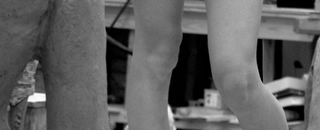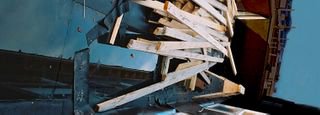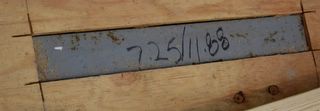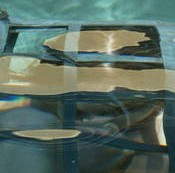August 03, 2013
March 20, 2007
poem 16
like little kings, my arbitrary breaths order me imperative
by a single hale drawn, in and in, within this core;
emptying its hunger, life’s single sin;
burnt quiet within, letting warmth return past this skin,
just here: in, and in, and in;
where venting air kills by use,
void sucks void, consumed in arbitrary bidding . . . it is this wasted air,
rubbing me dry, blown down and deserted,
each beat denying that peace taken of death; any world’s rightful dream;
that quiet rest it sits within, in which, it itself inheres, alone and sole, but stillborn made,
by
like a kingdom composed of carted stone, warmly held through dismantled time,
it slips past each me that beats inside,
just here, alone in time;
in, and in again,
and in.
so breath rattled, whistles past my toothy cage,
but will un-joined, is thrown out again, but still pressing firm,
returns to be owned; a void still less than home, mere simple aid to bone,
enduring briefly with intermingled soul transformed,
life’s pulsate tissue wetly conjoined, strips breath, brought chaff and dry,
like clumps of death, broken upon dry skin,
bent to limbered breathing; unjustly receiving . . . and so exhailed again.
and so a war is raged, ukase driven,
rival marching orders given,
across steppes of endless thirsting, necessity licking the upturned hands
burnt from asking, for the slightest rain.
in and in and out again.
my drying breath alone can bring
now raised to voice, ignorant of all reason lacking;
ordered lives now begging, a chorus asking,
and indulgence producing
ukiyoe . . .
an utterly simple whisper;
moving without pleading, without listening
inexorably to celebration, culminating before considering,
releasing by wailing: joy . . .
by necessity we ululate . . .
the arbitrary breath need letting loose,
of breath punctuating living,
through living breath, we beat.
October 06, 2006
October 05, 2006
October 03, 2006
Figural Underspecification: Change and Stability
...............................................................................................................Odo Marquard
Damn a people who cant [sic] handle or be handled
by more than a single God. Those slaves, those wisps.
.....................................................................George Bowering
Because metaphysical claims are fundamental, they must apply to all objects across all times. While this might mean that all buildings "exist" in the same way, it does not mean they all operate meaningfully in identical fashions. Their meanings, while based on the never changing essential nature of reality, exist as the related structure between that condition and the ever-changing human perspective and organization of it. Buildings are born within their originating context; the endlessly complex background of their original conceptual and physical setting. However, that context is constantly evolving and buildings quickly find themselves in changed situations. The fundamental character of a structure allows it to transcend such change within the range of its potential. However, sometimes the landscape changes to the point that existing forms can no longer maintain their meaningful participation. There is, therefore, a need to build a character capable of providing a multiple range of possible meanings.
Figural underspecification utilizes the potentially broad range of meaningful complexity which can be ‘built’ into a form. “Underspecification,” a term borrowed from linguistics, denotes a design which does not stamp a singular “correct” pattern upon its form. Instead, the components which comprise its formal potential are under-designated such that they do not coerce an unequivocal formal reading. Traditionally fixed codes are stretched so that they entertain a potential of ambiguity, allowing them to apply to new situations without the need for a completely new formal creation. It remains important that the overall code not be overly compromised in the process. Here it is a question of what is the appropriate balance and rate of progression at which a form needs to retain some degree of recognizable government. If meaning is to be at all comfortably achieved, the past (1) (established institutions and conventions) in some form is indispensable. A fully new discourse drawn from the saturated openness of the present is extremely difficult, if not impossible, to fulfil. Perhaps Arnold Schoenberg’s work sits at the furthest possible edge from the past. His invention of twelve-tone or serial composition for atonal music remains a rare example of a creation based on an originary rejection. (2) By establishing a structure of unity and coherence for atonality, he radically challenged the inherited foundations of musical sense. However, even in such a violent revolution, Schoenberg, and this may almost sound nonsensical, did not challenge “musicality” itself. It is a musical language nonetheless. It opposes the exclusivity of the chromatic scale, the exclusivity of thirds in building harmonic combinations, and even the requirement to resolve dissonance into consonance; but in doing all of this it reinforces these issues as the ultimate components of musical argument. In other words, he systematically enforced the negation of tonality (a refusal of a single tonal centre), but in so doing, by guaranteeing their equality, he supported the centrality of the singular tone itself.
What Schoenberg did do was to largely compromise the inherited code. The resulting challenge of this act remains. His negation of the past was to such an degree that its doctrine has never achieved its full resolution. Schoenberg himself questioned whether it was fully possible to put into practice. Theodor Adorno, an enthusiast of Schoenberg, acknowledges the degradation of meaning which was atonality’s ultimate sacrifice. “It dies away unheard, without even an echo. If time crystallizes around that music which has been heard, revealing its radiant quintessence, music which has not been heard falls into empty time like an impotent bullet. [. . .] Modern [atonal] music sees absolute oblivion as its goal.”(3) Such is the fate of extremity. But I think that the real lesson, one even Schoenberg accepted, is that we cannot create without the past any more than we can by slavishly adopting it in toto. Except for the chimera of creation ex nihilo, invention and adaptation “. . . [depend] upon an act of double-recognition, of both a model (even if we cannot name it) and the [ ] transformation of it.” (4) This is definitive of the Classical use of figures, and illustrates how figuration is a metaphor for creative presentation and representation. The idea of underspecification can now be seen as merely an analytical drawing out of the essence of figuration itself.
In the case of underspecification, when trying to establish a meaningful formal compliance to unstable conditions, the question becomes one of where the model is to be accepted and where it begs to be transformed. Sometimes the inertial force of tradition, like the character of the city, alone propels its continued adoption, and major misfits between form and functionality are required to fuel change. While radical transformations must often be restricted to limited (small) aspects of the whole, it is equally the case that “. . . the most rigidly deterministic conceptions of the world are the ones which generate in the individual will an urge to move forward, as though will and free choice can only be effective if they carve out their openings against the hard rock of necessity.” (5) This after all is at the very definition of individuality. It is the locus of each and every subject, and therefore a general characteristic of humanity and all its cultures. The need for movement, against either the conventional or the normal, is rooted in the conceptual misalignment between subjectivity (ultimate finitude) and objectivity (ultimate inclusive infinitude). We can go so far as to say that such operations are what sustain subjectivity . . . its need to forever identify itself against its world; even if that world is the matter by which this is accomplished.
This is why it is critical to open the range of meaningful readings and the valency between them. (6) Works which behave polyphasically in their form, create a space of autonomy for subjective awareness. (7) By virtue of one meaning, from another, and vice versa (and multiply so, in criss-cross fashion, by further interferences), persons gain a form of freedom. Monophasic works oblige the subject to recognize a single meaning. Whereas the subject-object relationship is static it tend towards atrophy. Such work is dangerously restricted in its identity because of a lack of internalized non-identity. In other words, the freedom which accompanies non-exclusivity equals multiplicity. It involves the separation of the powers, already potential in a patterned object, into a manifold of formal aspects; aspects which are therewith left up to individual determination. The building is polysemous but only so far as human desire demands. Here again we see the forces of the individuality of subjects at work. By allowing a figure to recognize its inherent ‘landscape’ qualities, its internal compound elaboration; figural underspecification enhances the individual’s freedom of experience. By being formed so that certain strong readings cannot fully specify how it is encountered, a building is free to be understood, or even used, in a number of different ways. A re-investment by architecture in the potential of figural processes offers the hope of letting go of the conservative constraints unnecessarily imposed upon the figure . . . allowing it to accommodate both order and disorder. By shaping the limits of underspecification, formal adaptability over a range of potential contextually driven changes becomes possible.
(1)The past here stands for the ‘already determined,’ if we can even speak in such strong words.
(2) I am indebted to the formulation of atonality in Bruce Murphy, ed., Benet’s Reader’s Encyclopedia, Fourth Edition (New York: HarperCollins, 1996): 61.
(3) Theodor Adorno, Philosophy of Modern Music, trans. Anne G. Mitchell and W. V. Blomster (New York: Seabury Press, 1973): 133.
(4) Donald Mitchell, The Language of Modern Music (London & Boston: Faber and Faber Ltd., 1993): 97.
(5) Italo Calvino, “Denis Diderot, Jacques le Fataliste,” in Why Read the Classics, trans. Martin McLaughlin (Toronto: Alfred A. Knopf Canada, 1999): 110.
(6) I am indepted to the analysis of Odo Marquard for these thoughts. See the section entitled “Monomythical and Polymythical Thinking,” of his essay “In Praise of Polytheism,” in Farewell to Matters of Principle: Philosophical Studies (esp. page 93).
(7) polyphasic a. (OED, paraphrased): commonly used to describe an electronic design which simultaneously supplies or uses several different alternating currents which share the same voltage but are out of phase (the particular stage of their periodically recurring sequence of charges). [f. POLY + PHASE]
More generically, polyphasic describes a form which simultaneously carries several different sets of ‘information’ which share the same ‘language’ but exist in separate phases of the structure. As such they can be ‘picked-out’ by a reading which is in phase with their diffence. (note: one of the denotations of the word phase in the OED is: “3. (Chem.) Physically distinct form of matter that can be present in a system.”)
September 29, 2006
June 23, 2006
An atom, with the firmament compared
And all her numbered stars, that seem to roll
Spaces incomprehensible (for such
Their distance argues and their swift return
Diurnal) merely to officiate light
Round this opacious earth, this punctual spot,
One day and night; in all their vast survey
Useless besides, reasoning I oft admire,
How nature, wise and frugal could commit
Such disproportions, with superflous hand
. . .
................................................Milton
June 14, 2006
June 01, 2006
thoughtnote 5
-
Above our sex, we split again . . . so that we can interact with the world at some separation from gravity’s reign: and so find the possibility to interact also with ourselves. With our back curved against the world, we focus our being to the front and physically form the loop in which the universe miraculously becomes self involved.
poem 015
(again)
poetry ends
(forever)
like time
(bored)
drawn from magazines
(quiet)
sitting still
(always)
in the face
(fronting)
all pain.
April 21, 2006
April 05, 2006
March 31, 2006
poem 014
March 26, 2006
March 24, 2006
March 15, 2006
March 14, 2006
poem 013
In dark matters I abound,
surrounded by walls I cannot sound,
as poet I write whatever on,
wanting paper, serves as ground.
Scarred and scratching,
the mess into heaps; eccentric laughing,
with ideas messed with grime,
I turn to forms precise,
and figure my interest pointedly.
Thus, in manner, I speak to me,
pounding a course from letters wrung,
or using my sharpened lead I pull,
a line whose product begins the start,
of a world from part I come.
From out that centre I present,
by negatatives within mind’s reform,
tending myself past the peace,
of quiet calm reigning sovereign,
where my intent always furthers
places I need yet create.
March 10, 2006
March 03, 2006
February 27, 2006
1 for Clo
Ambiguity
ambiguity n. (OED): Double meaning; instance of this; expression capable of more than one meaning. [ME, f. OF ambiguite or f. L ambigiguitas]
ambiguous a. (OED): Obscure; having double meaning; of doubtful classification; of uncertain issue. [f. L ambiguus doubtful f. ambigere (ambi- both ways, agere drive) + OUS]
Grammatical Ambiguity (Lexical or Syntactic Ambiguity): refers strictly to instances where the grammar specifies more than one meaning. It is distinct from cases in which the grammar specifies a single representation that then corresponds to potentially multiple refents. Grammatical ambiguity is internally generated. While it may not be fully systemic, it is a systematic product of either syntax or lexicon.
The interesting thing about systematic polysemy is its ability to become conventionalized, and so enter the structure of overt cultural norms. Our ability to process this kind of ambiguity depends upon a number of abstract and pragmatic issues. Interpretation is governed by things like useablity, as well as standards of meaningfulness like connection and coherence. Limited interpretations can then become conventionalized for different isolated requirements (useful or symbolic). This is the normal process by which comfort is achieved against multiplicity. In the same vein, uncertainties of interpretation are usually not recognized at all, provided a suitable conventionally driven understanding can be achieved without undo difficulty. Standard assumptions concerning the nature of things prevent us from straying into the “unknown” realm of other possibilities. This is most strongly the case when the ‘language’ used is a commonly shared code based upon pragmatic requirements. Both the independent life (order) of the code and the pressing need for which it used determine the depth to which our assumptions govern our perceptions.
thoughtnote 4
thoughtnote 3
...........You alone knew
...........that movement and stasis are one,
...........that the void is fullness and the clear sky
...........cloud at its airiest. . . .”
................Euginio Montale, “Xenia I,” in Satura {Poems}, trans. W. Arrowsmith (New
................York: W.W. Norton & Co., 1998): 19.
thoughtnote 2
This double aspect contributes to the dialectics which propel cultures through change. Recently, this debate has questioned the foundations of western culture to their core. Modern thought, a tradition now in its own right, increasingly falls under attack by forces seeking a more inclusive, open and flexible culture . . . one more suitable to the increasing complexity of our means of interrelation and dividing up work, wealth and power. However, this attack does not preclude the complexity inherent in the deep structures of modernity. It is possible to strip away the biases external to the foundations of modernism and allow its foundations to inform us through the complexity which has so often been misunderstood, ignored, misrepresented or covered up by the powers that be. Such a resurrection must start with revisiting the metaphysical sites of the modern impulse. One such group of sites is that of the constructed subject and its implications. We exist as subjects and all enquiry ultimately begins there. However, subjects exist as part of reality as a whole, and as such, any inquiry into subjectivity immediately becomes an inquiry into the nature of reality itself.
thoughtnote 1
thoughtnote 0
“There is something that wants to live, something that opens a passage [a spatial loop?] across matter, or in spite of matter.”
........Jorge Luis Borges, “Immortality” in Selected Non-Fictions, ed. Eliot Weinberger, trans. E. Allen, S.J. Levine and E. Weinberger (New York:Viking, 1999.): 489.
February 02, 2006
January 08, 2006
poem 012
The line’s end
Trying to find the end of places,
crisp-eyed, out running from stilled standing,
finding ends within cluttered traces
across papered spaces, mirrored looks
over edges, cuttings, knife-edged stable landing.
Because lines seen, divide and multiply,
I cannot understand that my eyes see an end,
because lines exist to hold the sides they imply
whatever surface or volume over which they tend;
we all look to find some standing reply
some reliant line up which our backs ascend.
Then standing, we walk a path, crossing lines we do not see.
Feeling our movement progress – like dancing through a fill
which emotion calm-in-place, yet creating questions for free . . .
................free, free, freedom looks at infinity,
................and freely balks losing with feeble nerve, it’s will.
Like a wall, at its opening, seeing the same wall; another
..............hole and glassy reflection traced over the outside tract
................understanding its many edges makes clear
the idea of outside . . . is it there or here?
December 18, 2005
October 29, 2005
October 27, 2005
October 14, 2005
September 11, 2005
August 31, 2005
August 26, 2005
The Status of the Theoretical Project
Architecture is a discipline with a very wide cultural base. It reflects the full complexity and ambiguity of 'knowing' in the profound sense because it combines the dipoles of practical and poetic life. It is not merely that it combines the aesthetic with the structural, the technical, the rational (order and program), the sensual and the intellectual (historical memory, the symbolic, etc.), but that it operates as an 'art' and a 'thinking' of all of those components as well. In philosophical jargon, real architecture is always both itself and meta-architecture . . . it operates as both a specific object and as a set of relationships and qualities which engage across the whole of culture. Perez-Gomez claims that theory is always embodied theory (embodied within practice). It is difficult to assess the truth of this claim, especially in its hard form that theory is intrinsic with the full nature of the practical. Heidegger's understanding of how we dwell amongst things, how we orient and find belonging through our interrelation with things at hand and things made by hand, shows that the opposite is surely true. Practice always involves the theoretical; directly or without intention. However, theory can stand significantly apart, within what we call the ideal; a thin, reduced, and thus abstract connection to reality's infinitude. Its participation in the fullness of culture is governed by a coefficient of unrealizability which arises through its interaction with the real (existing, in part, outside of its control). This supports the argument that theoretical projects are meta-architectural, and however important as disclosing, critical or inventive explorations, they cannot constitute architecture proper.
In Hejduk's work, especially his inclusion of the written word as an architectural device, the question becomes whether the boundaries of architecture are elastic enough to include written language. Heidegger's explication of language as the "house of being" is misapplied by Perez-Gomez in his effort to directly relate it to architecture while negating the peculiar qualities which give architecture its noumetic identity. Language involves a displacement, allowing for indirect reference to the eidetic in experience, but architecture's reference is of a different kind. Architecture does not exist as displaced from fundamental reality, but exists as a part of it . . . it exists within and without of experience. It straddles between the ideal and the real. It relates to life's complex of physical, emotional and intellectual intentions by making 'place' which reflects, suggests, encourages, permits, discourages or excludes them from possibility. Furthermore, architecture's explication of life's richness requires of its occupants a participation of equal attention. Architecture is completed through its occupation.
Hejduk's use of words to search for a figural ground provides a powerful criticism of the generalized loss of poiesis within the mainstream of modern culture, but it ignores the real need for the reintroduction of poetics into the very fabric of architecture; into its own devices and referential systems. Heidegger's notion of 'naming' is epistemologically prior to metynomy, and is not approached through such literal devices. Even complex narrative cannot stand in substitution for the inherent meanings of architectural organization, structural expression, colour, texture, material and form. At the deepest level, it is wrong to claim that the theory which reflects the mind is no longer a logos, but a poiesis. The revelation of Heidegger is that the ultimate ground reveals itself as a point of collapse between these two. Hejduk's work, as concrete poetry, as storia remains as fiction, a luxury which real architecture cannot afford. Real architecture satisfies by maintaining an uneasy equilibrium between logos and poiesis.
Notes -
1. Alberto Perez-Gomez, “John Hejduk and the Cultural Relevance of Theoretical Projects,” in AA Files, no. 13, Autumn 1986: 26.
2. By this I refer to his discourse which pits common sense opposites against each other at the profound level of ontological and metaphysical foundations. For example: poiesis against logos, prose against poetry, the specific and mutable against the ideal and universal, and further; disclosure of meaning against invention, and modern body image against that of the Classical.
































